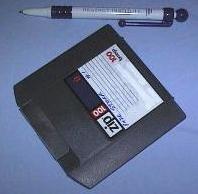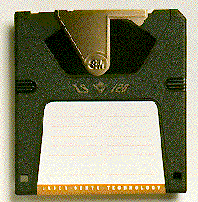

What is the current state of the art ?
| SyQuest was the original manufacturer of this sort of magnetic media and it had the market to itself until late 1995, when IoMega entered the market. These two manufacturers make competing products and this has started a race to make the highest capacity, fastest, easiest to use and lowest cost per Meg, High Capacity Magnetic Media technology. The only problem with this technology is that each manufacturers products have unique drive hardware and media, and so media used on one product will not work in another manufacturers drive. To make the situation even worse, each manufacture has more than one capacity drive and media. By the end of 1997 the 100 Meg IoMega ZIP disk had the major share of the High Capacity Removable Media market and their 1000 Meg JAZ drive was starting to sell Well. |  |
During 1997 SyQuest had a series of similar products ranging in capacity from 135 Meg to 270 Meg but these did not sell anywhere near as well as the IoMega products. In 1988 SyQuest released the 1000 Meg SparQ disk system, the 1.5 Gig Syjet and IoMega a 2 Gig version of the JAZ drive. On a less favourable note, the SyQuest company was in the hands of receivers late in 1998 and some doubt about their survival existed.
Compaq and 3M developed this high capacity removable magnetic media that is compatible with existing media. When this technology was being developed it was callled LS-120 but the name has been changed to SuperDisk. The idea behind SuperDisk is that you can read and write 1.44 Meg and 720 K Floppy Disks, on the same drive you use to read and write the new 120 Meg media. I have taken the liberty of reproducing a small protion of the 3M Web pages here, because of congestion on the Internet.
While the SuperDisk diskettes and drives look much the same as standard 1.44 MB diskettes and drives, the technical differences are substantial. A comparison of key specifications follows:
SuperDisk Technology -- A Look Inside
SuperDisk technology achieves advancements in capacity and performance by employing a unique combination of proven optical and magnetic technologies.
SuperDisk technology places laser servo tracks (hence the original LS designation) on each diskette that are both written and read by a laser system. A precise servo pattern is permanently etched onto the SuperDisk diskette media in tracks, sometimes called optical tracks. This laser etching is done at the factory and cannot be accidentally erased by an end user.
When a SuperDisk Diskette is inserted into an SuperDisk drive, an optical sensor detects a laser beam to locate the optical track and give the read/write head precise positioning information. This method enables advanced data track densities of 2,490 tracks per inch versus 135 tracks per inch for a 1.44 MB diskette.
Data tracks are written and read magnetically. The SuperDisk drive features a dual gap head that enables it to read and write both SuperDisk diskettes and standard 1.44 MB diskettes. The drive also spins the media at a higher speed than other diskettes, resulting in faster data access times and transfer rates. The 1.44 MB diskettes do not gain additional capacity when used in an SuperDisk drive, although the faster rotational speed allows the SuperDisk drive to read and write a 1.44 MB diskette up to three times faster than standard drives.
To support the high data density, the SuperDisk Diskette features higher coercivity (metal particle) pigment and advanced dual layer coating technology. The media is coated onto a thin (.0025 inch vs. .003 inch for 1.44 MB diskettes) polyethylene terathalate (PET) substrate for better head-to-media contact. The diskette also uses precision-engineered components such as a new stainless steel shutter and advanced hub for improved reliability. A sturdy, molded ABS shell provides superior protection for the media.
All SuperDisk Diskettes are factory formatted to save users' time and provide a consistent format for data exchange.

SuperDisk diskette technology fact sheet
SuperDisk Technology Versus Standard Diskette Technology
Specifications: SuperDisk: Standard HD: Formatted Capacity 120 MB 1.44 MB Transfer Rate (max. sustained) 565KB/sec 62KB/sec Average Seek Time 70 msec 84 msec Track Density 2490 tpi 135 tpi Number of Tracks 1736 x 2 sides 80x2 sides Disk Rotational Speed 720 rpm 300 rpm Power Consumption +5V, 1.5W +5V, 1.2W 
Mini-Disk
This is a tiny 60mm diameter magneto-optical disk designed by Sony in 1992 and intended for the Audio industry. In 1993 Sony released a data version with a storage capacity of 140Meg, and in 1996 Sony announced a 650Meg version. mini-Disk was slow to take off in the Audio field and has seen very little use in PC Computers as yet.
Back to the opening index
Book four index
Copyright © Phil. Storr, last updated 4th December 1998